NASA Award Helps Doctoral Student Develop Space-Structure Composite Materials
Second-year graduate student Andrea Hoe grew up designing and building projects with her father in their backyard. She also loved spending time with her family surveying the night sky. As a young child, she wanted to be an astronaut. So,…


 On the surface, it would seem that zebrafish and humans are about as different as, say, developmental biologists and theoretical physicists. Fish swim; humans walk. Biologists revere Charles Darwin; physicists have an abiding admiration for Albert Einstein. It turns out, however, that zebrafish and humans are very similar during the earliest stages of embryonic development. So much so, that developmental biologists study zebrafish embryos to help answer such questions as how do organs end up on the correct side of the human body? Turns out, the question is also interesting to a Syracuse University physicist.
On the surface, it would seem that zebrafish and humans are about as different as, say, developmental biologists and theoretical physicists. Fish swim; humans walk. Biologists revere Charles Darwin; physicists have an abiding admiration for Albert Einstein. It turns out, however, that zebrafish and humans are very similar during the earliest stages of embryonic development. So much so, that developmental biologists study zebrafish embryos to help answer such questions as how do organs end up on the correct side of the human body? Turns out, the question is also interesting to a Syracuse University physicist.